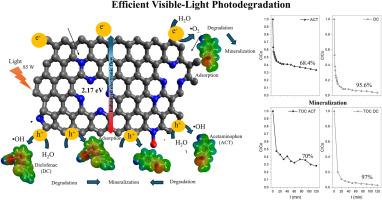Peroxide-driven activation on NH2 and graphitic-N doped rice-residue carbon for e−/h+ mediated degradation of acetaminophen and diclofenac
IF 8.1
2区 环境科学与生态学
Q1 ENVIRONMENTAL SCIENCES
引用次数: 0
Abstract
This study presents a novel, sustainable, and metal-free photocatalyst based on nitrogen-doped carbon derived from pre-carbonized rice residue (CRHN) for the visible-light degradation of acetaminophen (ACT) and diclofenac (DC). Synthesized via urea-assisted pyrolysis, the material incorporated NH2 and graphitic-N groups, enhancing surface basicity and reduced the band gap from 2.5 to 2.16 eV. Under optimal conditions (85 W, 0.1 g L−1, pH 7), CRHN achieved mineralization efficiencies of 97% for DC and 70% for ACT within 30 min, outperforming the undoped material. Kinetic modeling followed a pseudo-second-order model, with rate constants of 0.022 and 0.002 L mg−1 min−1 for DC and ACT, respectively. Scavenger experiments confirmed the dominant role of pairs, supported by •OH radicals in a peroxide-driven mechanism. Moreover, adsorption was negligible due to the low dosage of CRHN needed in the experiments. These findings highlight CRHN as a high-performance and eco-friendly photocatalyst for pharmaceutical degradation, promoting sustainable water treatment and agro-industrial waste valorization.

过氧化氢驱动的NH2和石墨- n掺杂稻渣碳对e- /h+介导的对乙酰氨基酚和双氯芬酸的降解
本研究提出了一种新型的、可持续的、无金属的光催化剂,该催化剂基于来自预碳化稻渣(CRHN)的氮掺杂碳,用于可见光降解对乙酰氨基酚(ACT)和双氯芬酸(DC)。通过尿素辅助热解合成,该材料加入了NH2和石墨- n基团,提高了表面碱性,并将带隙从2.5 eV减小到2.16 eV。在最佳条件下(85 W, 0.1 g L−1,pH 7), CRHN在30分钟内实现了97%的DC矿化效率和70%的ACT矿化效率,优于未掺杂材料。动力学建模遵循伪二阶模型,DC和ACT的速率常数分别为0.022和0.002 L mg−1 min−1。清道夫实验证实了在过氧化物驱动机制中由•OH自由基支持的e−/h+对的主导作用。此外,由于实验中所需的CRHN用量较低,吸附作用可以忽略不计。这些发现强调了CRHN作为一种高性能和环保的光催化剂,可用于药物降解,促进可持续水处理和农业工业废物的增值。
本文章由计算机程序翻译,如有差异,请以英文原文为准。
求助全文
约1分钟内获得全文
求助全文
来源期刊

Chemosphere
环境科学-环境科学
CiteScore
15.80
自引率
8.00%
发文量
4975
审稿时长
3.4 months
期刊介绍:
Chemosphere, being an international multidisciplinary journal, is dedicated to publishing original communications and review articles on chemicals in the environment. The scope covers a wide range of topics, including the identification, quantification, behavior, fate, toxicology, treatment, and remediation of chemicals in the bio-, hydro-, litho-, and atmosphere, ensuring the broad dissemination of research in this field.
 求助内容:
求助内容: 应助结果提醒方式:
应助结果提醒方式:


